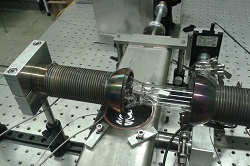Sparking a better understanding of biofuel potential for a cleaner environment
Biofuels have long been trumpeted as a promising solution to the challenge of meeting ever-increasing energy and transport needs, more safely and sustainably than conventional sources. So-called second generation (2G) biofuels - usually made from biomass such as plant and animal matter (sources of organic carbon) – offer the potential for such a worldwide fuel supply. 2G improves upon the first generation (made from sugars and vegetable oils) as it does not have the same limitations in terms of retrievable quantities. However, the challenge for the widespread adoption of 2G for the aeronautical and automobile industries for example, is that there are still aspects of its combustion processes which are not fully understood. This compared to our comprehension of the oxidation/combustion mechanism of the hydrocarbon molecules in conventional fuels. This is largely due to the wider range of chemical structures involved in the mix. The EU funded 2G-CSAFE project was set up to fill in some of these data gaps by developing kinetic models and looking specifically at combustion-generated pollutants and key-intermediates for fuels ignition in new engines. Kinetic modelling The 2G-CSAFE project team developed a number of 2G biofuel kinetic models because, as the project coordinator Dr Philippe Dagaut explains, ‘A kinetic model can be defined as a numerical tool that will be used to mimic, and possibly predict, the combustion of fuels.’ The blended composition of 2G-biofuels makes them especially complex and so the team used surrogate fuel compounds in their models, being able to extrapolate from their findings. As Dr Dagaut elaborates, ‘Models for the combustion of hydrocarbons are relatively easy to write thanks to numerous efforts since the 1970s. For second generation biofuels, this is different: their chemical structures make them react differently, both in terms of rate of reaction or reactivity, and in terms of reaction pathways.’ The project investigated several 2G biofuel features. Firstly, the chemical reactions of the numerous steps necessary for combustion (from the fuel-air mixture to the formation of water and carbon dioxide as end products, but also that of unburnt species like volatile organic compounds or polyaromatic hydrocarbons). Secondly, it tracked the parameters describing the rate at which each chemical reaction proceeds. According to Dr Dagaut what made the research especially challenging was that the team were in unchartered territory. As he recalls, ‘Starting from scratch, the road to success is always longer than expected. For example, measuring quantitatively the radical HO2 was more difficult than expected; extracting ignition parameters from the micro-flow reactor experiments was not as simple as initially thought.’ Blazing a trail with world firsts Overall, 2G-CSAFE has demonstrated that what matters most is the precise fuel mix. Biofuel combustion has been shown to be more hazardous in some cases than that of conventional fuels. As Dr Dagaut summarises, ‘Depending on the fuel structure of biofuels you can get less polyaromatic hydrocarbon pollutants, for example with alcohols and esters, or more than with conventional fuels such as 2,5-dimethylfuran.’ The research has also demonstrated the importance of some typical reactions such as molecular elimination in the case of oxygenated fuels, whereas these reactions are often neglected for hydrocarbons. The project has created several practical tools and methodologies, many of which are world firsts. For example, it obtained the first quantitative measurements of HO2 radicals, during the oxidation of fuels, using a jet-stirred reactor – sampling cone – cavity ring-down spectroscopy assembly - a major achievement due to the importance of this radical for ignition. Using a micro-flow reactor, the project was also able to measure frequency for Flames with Repetitive Extinction and Ignition (FREI), as well as the first observation of oscillating weak flames - behaviour which was predicted but never observed before. Phenomena which could have significant implications for the use of micro-combustors as viable battery replacements. The team is currently working on further validation of the combustion models for the most complex biofuels. It is also further exploring plasma-assisted ignition and combustion-control, building on the project’s discovery that in homogeneous charge compression ignition (HCCI) engines, adding small amounts of active species separately and mixed (NO, NO2, O3) held great potential for increased efficiency.







